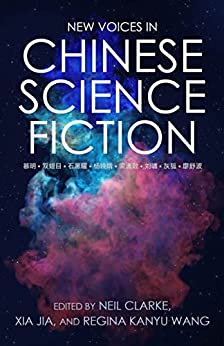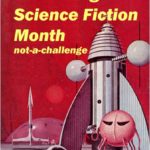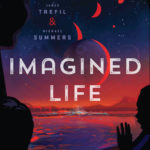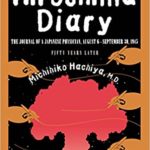In her introduction to New Voices in Chinese Science Fiction, Xia Jia explains how she and the other editors selected and found translators for the work of eight writers who had never before had their stories presented to the English-speaking world. I found the eight stories the editors chose to be fascinating. Several are brilliant by any standard, others more revealing of the different traditions of Chinese science fiction and the imaginative exuberance of the writers in reinterpreting them for new audiences. Most of the writers are well-established figures in China, and it’s unfortunate that we don’t have more of their work to read. These are “new” voices in Chinese science fiction mostly from our perspective, and that says a lot about how much the Anglophone world needs to open up to the great new literature of China. I’m still absorbing these stories, but five out of the eight in this volume made an especially deep impression.
There are two stories in New Voices in Chinese Science Fiction, “The Bridge” by Liu Xiao (translated by Andy Dudak) and “By Those Hands” by Congyun ‘Mu Ming’ Gu (translated by Judith Huang) that dramatize the confrontation of traditional skills developed by gifted individuals and modern technical thinking and scientific innovation.
In “The Bridge”, Old Ji, who is now bent, weakened and a figure of ridicule, was once a great bridge jumper in the mountain village of Summit Town. We don’t get an explanation of exactly what the Canted Bridge is or how and why it was constructed. It is simply there, like a natural wonder, connecting Earth with another world called Magna Luna. The bridge is a massive structure that periodically swings past Summit Town, stirring up gale-like winds, but giving a chance for a cadre of bridge jumpers to leap up and try to grab its wind-worn sides.
We see Old Ji in his earlier years as a heroic figure leaping up to grab the underside of the vast and terrifying structure as it sweeps across the mountain side. For the village as a whole, the Canted Bridge was like a “precise pendulum, delineating everyone’s rhythm, habituating them to lives beginning and ending on the mountain-top.” They had little interest in life outside their town. Then one day two strangers appear in a four-wheeler and ask a lot of questions about this location that comes so close to the bridge. That visit leads to dramatic changes in the bridge and the introduction of new technology that renders the art of bridge jumping a relic of the past. The story becomes one of forced adaptation to the new and a testing of the relationship between the older and younger generations.
“By Those Hands” dramatizes a more problematic displacement of traditional expertise by new technology, in this case artificial intelligence. The story begins as a third person narrative about Old Tang who is a master craftsman at bamboo weaving. We learn in great detail about his extraordinary skill to cut bamboo into incredibly fine strands, as thin as human hair, then weave them into the most complex designs. His work is flawless because, as he sees it, he possesses a stillness of soul that younger people have lost.
Then the story switches to a first person narrative of a brilliant student in neuroscience who is intent on mapping the fine neural circuits of the brain. His goal goes beyond that, however, to produce a mechanical model of one of the most complex products of human neural activity, the human hand. His aim is to train a mechanical hand to produce work that is just as fine as Old Tang’s bamboo weavings. That would be only the start of his effort to develop AI to reproduce all the human senses. This sets up a conflict between the the craftsman and the scientist’s new invention that is ultimately more about human adaptation to change than violent displacement.
“The Bridge” and “By Those Hands” are brilliant stories, but the working out of the theme of new technology clashing with traditional knowledge at the end of each one seemed a bit facile, especially since the authors both raise deeper issues that at first point toward a much more difficult resolution.
“Tombstone” by Yang Wanqing (translated by Andy Dudak) has a much darker interpretation of the impact of dazzling new technology. It is set a few hundred years in the future after the Great Scattering of the twenty-second century, a series of disasters resulting in the destruction of economic life, a great energy shortage and the eradication of existing political and national structures. What remains are struggling groups of survivors, except in one corner of Alaska where the city-state of New Anchorage thrives, largely due to its inexhaustible supply of energy provided by the huge Osiris Tower, a black monolith towering high into the sky. The rulers of New Anchorage claim that it is a perpetual energy source, fed by the transformation of human neurons into Osiris particles. These mimic neural structure and provide an enduring soul for all the humans who choose to have their minds processed there before death. This is a haunting story about a loving relationship, the dissidents who try to unravel the tower’s truth and the nature of death.
“PTSD” by Hui Hu (translated by Rebecca Kuang) is an extended dialogue about the impact of virtual reality, the ethics of mass marketing imperfect equipment, surreptitious influence through surveillance and other issues but all wrapped up brilliantly in an exciting story. It focuses on three characters who have been traumatized in different ways, two of them turning to robots, exoskeletons and drones to seek revenge on the people who have caused their grief. Along with “Tombstone”, it explores the negative side of technological advance while focusing on both the damage to individuals and the guilt of those who manipulate people.
“The Kite of Jinan” by Liang Qingsan (translated by Emily Jin) is my personal favorite in this collection. As Xia Jia explains in the introduction the story takes the form of a fictional history of science. The narrator finds a mysterious 19th century photograph of a man named Chen Haining and his invention that resembles a strange kite. A later news article refers to Chen’s involvement in the explosion of a firearms factory in 1910 that cost him his life. The story consists of the narrator’s meticulous research to solve the puzzle of the photograph, which seems to depict a crude kite attached to a chair, and Chen Haining and exactly what he was working on when he died. It’s a wonderful science fiction detective story to uncover the nature of Chen Haining’s research and achievements.
New Voices in Chinese Science Fiction is one of those collections that I not only found deeply interesting at first reading but also wanted to go back at once to read all over again. We need more collections like this and also translations of the novels and other stories these eight writers have produced. I hope the editors and translators can keep on with this exciting work to bring the full scope of Chinese science fiction to the English-speaking world.





Leave a Reply